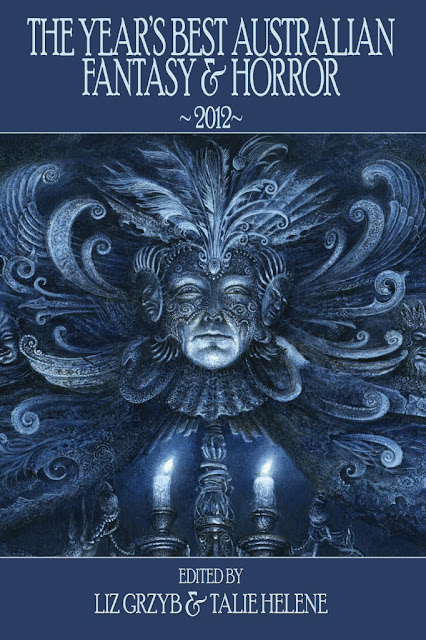
Sometimes, it is easy to forget that the publishing
industry is a business and like any business it is very difficult to survive
without a profit. This particular and important side of publishing becomes more
poignant in the case of small presses. The independent small publishing houses
are doing a tremendous job in promoting wonderful and original fiction, but
without a profit they would have a nigh-on-impossible chance of surviving.
Unless the owner of such a small press is in Forbes top 500 billionaires, in
which case profit might not be the prime concern. One of the small houses I was
sad to see having an extremely tough time is Rogue Blades Entertainment. The
three anthologies of short fiction published by Rogue Blades Entertainment, “Return of the Sword”, “Rage of the Behemoth” and “Demons”, brought back to life and to a
new dimension the sword-and-sorcery sub-genre. The adventurous and catchy
stories of heroics published by Rogue Blades Entertainment offered not only
action filled tales, but also character driven fiction. Unfortunately, the
publishing house didn’t do well on the market and although Rogue Blades
Entertainment didn’t die it entered in a stagnant stage.
However, after three years of standing still Rogue
Blades Entertainment released a new title, a non-fiction volume edited by Jason M. Waltz, “Writing Fantasy Heroes: Powerful Advice from the Pros”. When it
comes to fantasy I am fascinated by world-building and story, but as a reader
the most important elements for me in a book, indifferent of genre, are the
characters. And if a book has powerful, well-constructed characters I can more easily
overcome certain shortcomings of the respective volume. “Writing Fantasy
Heroes: Powerful Advice from the Pros” can come in handy for the aspiring
writers, but it is also an opportunity for the readers to take a glimpse in the
backstage of the character creation. Sword and sorcery is not renowned for the
emphasis on the characters, but done right it can show a side that can enhance
the appeal of this sub-genre. With a foreword by Steven Erikson, this non-fiction collection gathers some important
names of fantasy fiction, such as Cecilia
Holland, Glen Cook, Ian C. Esslemont, Brandon Sanderson, Paul
Kearney, Ari Marmell, C.L. Werner or Howard Andrew Jones, in an attempt to throw a light on the technique
and process of creating fantasy heroes and heroics.
Where are your heroes? Are they trapped inside the
stories in your head, eager to burst free? Are you ready to share them, to brag
of them, to tell of their deeds and battles, their daring and sacrifice? Are
you a storyteller ready to write the tales of your own heroes?
Fantasy heroes endure. They are embedded in our
cultural fabric, dwarfing other literary figures and the mere men and women of
history. Achilles and Odysseus, Gilgamesh and Beowulf. King Arthur and Robin
Hood, Macbeth and Sherlock Holmes, Conan and Luke Skywalker. They dominate our
legends, and tower over popular culture.
The stories we tell each other begin and end with
fantasy heroes, and the 21st Century is as thoroughly captivated with them as
ever. From Batman to Gandalf, Harry Potter to Tyrion Lannister, the heroes of
fantasy speak to—and for—whole generations.
But what makes a fantasy hero? How do the best writers
create them, and bring them to life on the page? In WRITING FANTASY HEROES some
of the most successful fantasy writers of our time—including Steven Erikson,
Brandon Sanderson, Janet Morris, Cecelia Holland, Orson Scott Card, and Glen
Cook—pull back the curtain to reveal the secrets of creating heroes that live
and breathe, and steal readers' hearts.
Whether you're an aspiring writer or simply a reader
who loves great fantasy and strong characters, this book is for you.
“Foreword” by Steven
Erikson
“The Hero in Your Blood”
by Janet Morris and Chris Morris
“The Heroic Will” by
Cecilia Holland
“Taking a Stab at
Writing Sword and Sorcery” by Ian C. Esslemont
“Writing Cinematic Fight
Scenes” by Brandon Sanderson
“Watching from the
Sidelines” by Cat Rambo
“Man Up: Making Your
Hero an Adult” by Alex Bledsoe
“Two Sought Adventure”
by Howard Andrew Jones
“Monsters – Giving the
Devils their Due” by C.L. Werner
“NPCs are People Too” by
Jennifer Brozek
“Tropes of the Trade” by
Ari Marmell
“So You Want to Fight a
War” by Paul Kearney
“Shit Happens in the
Creation of Story” by Glen Cook
“The Reluctant Hero” by
Orson Scott Card
“Afterword”
by Jason M. Waltz
I am happy to see Rogue Blades Entertainment coming
out of hibernation, making a tremendous effort with a non-fiction collection,
but with an interesting subject and a wonderful cover artwork. My hope is that
Rogue Blades Entertainment would not enter in hiatus again, would bring us new
titles in the future, at least at the level of its previous ones, and
eventually thrive.






















